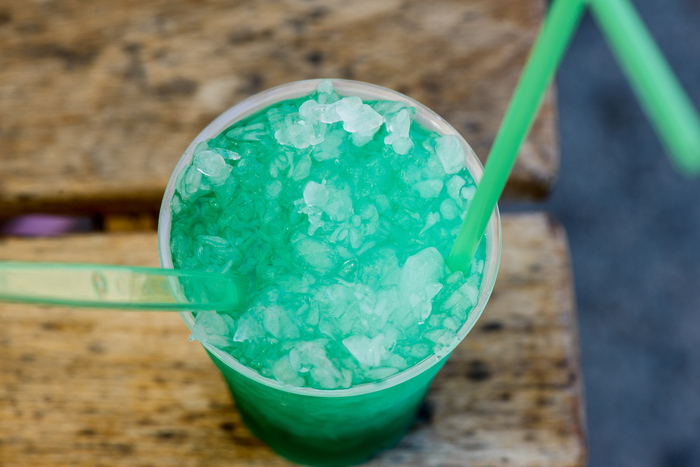"Scratch, scratch Checca": with these words a husband from ancient Rome asked his wife to scratch the "checca", or the block of ice recovered from the mountains and stored underground, to prepare the famous "
grattachecca
".
A traditional drink so refreshing and tasty that, centuries later, even Caterina de 'Medici requested a specialist to take with her to the court of the King of France to have her daily ration of "sweet and fragrant ice".
From the Renaissance we move on to contemporary history: the tasty mixture of Roman origin conquers the hearts and palates of all of Italy to the point of being called in different ways depending on the province of reference.
As reported by Treccani, the correct name in Italian is "ice", although it is sometimes called "granatina", in Naples they call it "rattata" or "cazzimbocchio", in Palermo "grattatella", in Bari "grattamarianna" and in Calabria "Scirubetta".
Regardless of the name and dialect, the classic recipe remains constant, which involves the use of
crushed ice with the addition of various types of syrup
, including mint, barley, lemon, almond milk or tamarind, black cherry and lemon.
Everything is sometimes enriched with pieces of tropical fruit such as coconut and cedar.
Furthermore, in terms of preparation, it is important to highlight the fact that
the ice must be coarsely chopped
(in this it differs from granita and cremolato) and left to rest for a short period of time.
Another point to remember: the grattachecca
must be consumed quickly
because, if it melts, it loses all its uniqueness.
This distinctive trait has allowed the well-known blend to go crazy
still
today in kiosks all over Italy.
And that's not all, the grattachecca has in fact assumed such importance to be chosen as the protagonist of "Unusually Refreshing Summer Tour" organized by Hendrick's Gin, an international brand specializing in the creation of the well-known distillate, scheduled from 22 July to 18 September.
“We will bring to Italy the freshness necessary to fight the summer heat - says Solomiya, Italy Brand Ambassador of Hendrick's Gin - The traditionality of the grattachecca, a historic drink and above all made in Italy, goes perfectly
with gin
.
We will create many tasty and thirst-quenching recipes to satisfy the hearts and palates of fans of the entire national territory during a tour lasting about eight weeks.
The recipe of our very personal grattachecca, as per tradition, involves the use of crushed ice enriched with about 3 ml of Hendrick's gin and 6 ml of syrup available in three variants, namely lemon, cucumber and rose.
In this way, people can temporarily escape from the hottest cities to experience the freshness of Scotland, the country of origin of our gin.
In addition to the tour, we also took advantage of the summer period to launch a new cocktail: it is "
Hendrick's & T",
the result of the encounter between Scottish gin and iced tea that are mixed with a mint leaf and a pinch of lime juice, giving freshness and energy ".
BRIEF HISTORY OF THE SKYSCRAPER
The history of the grattachecca, as already mentioned, starts from afar: in the age of ancient Rome, in fact, the writer Pliny the Elder in the work "Naturalis Historia" describes it as an ancestor of sorbet, defining it as " a drink consisting of finely crushed ice and honey with another portion of ice and fruit juice ”.
Another interesting curiosity concerns the snow necessary to obtain the ice useful for making the drink that was collected by the so-called "nevaroli": later the snow itself was packed in straw and transported on wagons, once it reached its destination it was pressed and stored in the special "neviere", that is fresh and often underground environments.
The path to discover the historic granita continues with the "Vesuvian acquafrescai":
they transported the ice through special carts and delivered it to kiosks to make the drink.
In the 1950s, in the absence of disposable glasses, the peddler on duty scratched the ice and deposited everything in the palms of the children, finally pouring the syrup to the desired taste.
Moving on to current events,
today the grattachecca is rigorously prepared by hand in the historic kiosks of the Trastevere districts (the most famous on the Lungotevere), Testaccio and Prati, located in the Ponte Milvio area and in the Trieste and Trionfale districts.
And that's not all: as evidence of its notoriety on a national scale, the scratcher even appeared in a question about the logic of the admission tests for the health professions at La Sapienza University.
Going more specifically to the national scratchy celebrations, the “Unusually Refreshing Summer Tour” is divided into two phases.
First of all, a daytime tour was organized with a lot of “Hendrick's Cargo Bike” in the main Italian cities that will offer consumers the spoon cocktail free of charge.
Secondly, in addition, there will also be an evening tour with two “Hendrick's Cargo Bikes” positioned in 90 selected locations throughout Italy.
For the occasion, two evenings a day will be organized in the same city in two different venues,
or the two most influential in the area.
The cities of the tour: Palermo (from 22 to 26 July), Catania (from 27 to 31 July), a good part of Calabria including Reggio Calabria (from 3 to 7 August) and Crotone (from 9 to 12 August), Lecce ( from 13 to 17 August), Bari (from 18 to 21 August), Salerno together with the Amalfi Coast (from 24 to 28 August), Versilia (from 31 August to 3 September), Rome (from 8 to 11 September) and Milan (from 14 to 17 September).




/cloudfront-eu-central-1.images.arcpublishing.com/prisa/ERGL3EY5MFESJLG3PJ56L4NVAY.jpg)



